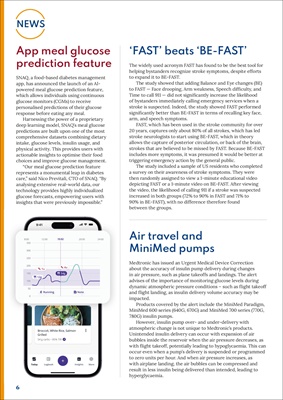
6
NEWS
App meal glucose
prediction feature
SNAQ, a food-based diabetes management
app, has announced the launch of an AIpowered
meal glucose prediction feature,
which allows individuals using continuous
glucose monitors (CGMs) to receive
personalised predictions of their glucose
response before eating any meal.
Harnessing the power of a proprietary
deep learning model, SNAQ's meal glucose
predictions are built upon one of the most
comprehensive datasets combining dietary
intake, glucose levels, insulin usage, and
physical activity. This provides users with
actionable insights to optimise their food
choices and improve glucose management.
"Our meal glucose prediction feature
represents a monumental leap in diabetes
care," said Nico Previtali, CTO of SNAQ. "By
analysing extensive real-world data, our
technology provides highly individualized
glucose forecasts, empowering users with
insights that were previously impossible."
'FAST' beats 'BE-FAST'
The widely used acronym FAST has found to be the best tool for
helping bystanders recognize stroke symptoms, despite efforts
to expand it to BE-FAST.
The study showed that adding Balance and Eye changes (BE)
to FAST - Face drooping, Arm weakness, Speech difficulty, and
Time to call 911 - did not significantly increase the likelihood
of bystanders immediately calling emergency services when a
stroke is suspected. Indeed, the study showed FAST performed
significantly better than BE-FAST in terms of recalling key face,
arm, and speech symptoms.
FAST, which has been used in the stroke community for over
20 years, captures only about 80% of all strokes, which has led
stroke neurologists to start using BE-FAST, which in theory
allows the capture of posterior circulation, or back of the brain,
strokes that are believed to be missed by FAST. Because BE-FAST
includes more symptoms, it was presumed it would be better at
triggering emergency action by the general public.
The study included a sample of US residents who completed
a survey on their awareness of stroke symptoms. They were
then randomly assigned to view a 1-minute educational video
depicting FAST or a 1-minute video on BE-FAST. After viewing
the video, the likelihood of calling 911 if a stroke was suspected
increased in both groups (72% to 90% in FAST and 71% to 90%
in BE-FAST), with no difference therefore found between the
groups.
Air travel and
MiniMed pumps
Medtronic has issued an Urgent Medical Device Correction
about the accuracy of insulin pump delivery during changes
in air pressure, such as plane takeoffs and landings. The alert
advises of the importance of monitoring glucose levels during
dynamic atmospheric pressure conditions - such as flight takeoff
and flight landing, as insulin delivery volume accuracy may be
impacted.
Products covered by the alert include the MiniMed Paradigm,
MiniMed 600 series (640G, 670G) and MiniMed 700 series (770G,
780G) insulin pumps.
However, insulin pump over- and under-delivery with
atmospheric change is not unique to Medtronic's products.
Unintended insulin delivery can occur with expansion of air
bubbles inside the reservoir when the air pressure decreases, as
with flight takeoff, potentially leading to hypoglycaemia. This can
occur even when a pump's delivery is suspended or programmed
to zero units per hour. And when air pressure increases, as
with airplane landing, the air bubbles can be compressed and
result in less insulin being delivered than intended, leading to
hyperglycaemia.